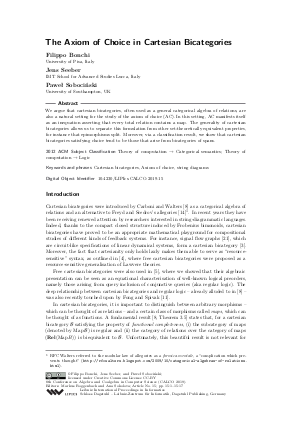The Axiom of Choice in Cartesian Bicategories
Authors Filippo Bonchi, Jens Seeber, Paweł Sobociński
-
Part of:
Volume:
8th Conference on Algebra and Coalgebra in Computer Science (CALCO 2019)
Part of: Series: Leibniz International Proceedings in Informatics (LIPIcs)
Part of: Conference: Conference on Algebra and Coalgebra in Computer Science (CALCO) - License:
 Creative Commons Attribution 3.0 Unported license
Creative Commons Attribution 3.0 Unported license
- Publication Date: 2019-11-25
File

PDF
LIPIcs.CALCO.2019.15.pdf
- Filesize: 0.52 MB
- 17 pages
Document Identifiers
Subject Classification
ACM Subject Classification
- Theory of computation → Categorical semantics
- Theory of computation → Logic
Keywords
- Cartesian bicategories
- Axiom of choice
- string diagrams
Metrics
- Access Statistics
-
Total Accesses (updated on a weekly basis)
0PDF Downloads0Metadata Views
Abstract
We argue that cartesian bicategories, often used as a general categorical algebra of relations, are also a natural setting for the study of the axiom of choice (AC). In this setting, AC manifests itself as an inequation asserting that every total relation contains a map. The generality of cartesian bicategories allows us to separate this formulation from other set-theoretically equivalent properties, for instance that epimorphisms split. Moreover, via a classification result, we show that cartesian bicategories satisfying choice tend to be those that arise from bicategories of spans.
Cite As Get BibTex
Filippo Bonchi, Jens Seeber, and Paweł Sobociński. The Axiom of Choice in Cartesian Bicategories. In 8th Conference on Algebra and Coalgebra in Computer Science (CALCO 2019). Leibniz International Proceedings in Informatics (LIPIcs), Volume 139, pp. 15:1-15:17, Schloss Dagstuhl – Leibniz-Zentrum für Informatik (2019)
https://doi.org/10.4230/LIPIcs.CALCO.2019.15
BibTex
@InProceedings{bonchi_et_al:LIPIcs.CALCO.2019.15,
author = {Bonchi, Filippo and Seeber, Jens and Soboci\'{n}ski, Pawe{\l}},
title = {{The Axiom of Choice in Cartesian Bicategories}},
booktitle = {8th Conference on Algebra and Coalgebra in Computer Science (CALCO 2019)},
pages = {15:1--15:17},
series = {Leibniz International Proceedings in Informatics (LIPIcs)},
ISBN = {978-3-95977-120-7},
ISSN = {1868-8969},
year = {2019},
volume = {139},
editor = {Roggenbach, Markus and Sokolova, Ana},
publisher = {Schloss Dagstuhl -- Leibniz-Zentrum f{\"u}r Informatik},
address = {Dagstuhl, Germany},
URL = {https://drops.dagstuhl.de/entities/document/10.4230/LIPIcs.CALCO.2019.15},
URN = {urn:nbn:de:0030-drops-114439},
doi = {10.4230/LIPIcs.CALCO.2019.15},
annote = {Keywords: Cartesian bicategories, Axiom of choice, string diagrams}
}
Author Details
References
-
Jean Bénabou. Introduction to bicategories. In Reports of the Midwest Category Seminar, pages 1-77. Springer, 1967.

-
Filippo Bonchi, Fabio Gadducci, Aleks Kissinger, Paweł Sobociński, and Fabio Zanasi. Rewriting modulo symmetric monoidal structure. In Proceedings of the 31st Annual ACM/IEEE Symposium on Logic in Computer Science, pages 710-719. ACM, 2016.

-
Filippo Bonchi, Joshua Holland, Dusko Pavlovic, and Pawel Sobocinski. Refinement for signal flow graphs. In 28th International Conference on Concurrency Theory (CONCUR 2017). Schloss Dagstuhl-Leibniz-Zentrum fuer Informatik, 2017.

- Filippo Bonchi, Dusko Pavlovic, and Pawel Sobocinski. Functorial Semantics for Relational Theories. CoRR, abs/1711.08699, 2017. URL: http://arxiv.org/abs/1711.08699.
- Filippo Bonchi, Jens Seeber, and Pawel Sobocinski. Graphical Conjunctive Queries. In Dan Ghica and Achim Jung, editors, 27th EACSL Annual Conference on Computer Science Logic (CSL 2018), volume 119 of Leibniz International Proceedings in Informatics (LIPIcs), pages 13:1-13:23, Dagstuhl, Germany, 2018. Schloss Dagstuhl-Leibniz-Zentrum fuer Informatik. URL: https://doi.org/10.4230/LIPIcs.CSL.2018.13.
-
Roberto Bruni and Fabio Gadducci. Some algebraic laws for spans (and their connections with multirelations). In Proc. RelMiS 2001, ENTCS, volume 44, 2001.

-
Carsten Butz. Regular categories and regular logic. BRICS Lecture Series LS-98-2, 1998.

-
Aurelio Carboni and Robert FC Walters. Cartesian bicategories I. Journal of pure and applied algebra, 49(1-2):11-32, 1987.

-
Brandon Coya and Brendan Fong. Corelations are the prop for extraspecial commutative Frobenius monoids. Theory and Applications of Categories, 32(11):380-395, 2017.

-
Brendan Fong. The Algebra of Open and Interconnected Systems. PhD thesis, University of Oxford, 2016.

-
Brendan Fong and David I Spivak. Graphical Regular Logic. arXiv preprint arXiv:1812.05765, 2018.

- Brendan Fong and Fabio Zanasi. Universal Constructions for (Co)Relations: categories, monoidal categories, and props. Logical Methods in Computer Science, Volume 14, Issue 3, September 2018. URL: https://doi.org/10.23638/LMCS-14(3:14)2018.
-
Thomas Fox. Coalgebras and cartesian categories. Communications in Algebra, 4(7):665-667, 1976.

-
Peter J Freyd and Andre Scedrov. Categories, allegories, volume 39. Elsevier, 1990.

-
Ichiro Hasuo and Naohiko Hoshino. Semantics of higher-order quantum computation via geometry of interaction. Annals of Pure and Applied Logic, 168(2):404-469, 2017.

-
Horst Herrlich. Axiom of choice. Springer, 2006.

-
Bart Jacobs. Categorical logic and type theory, volume 141. Elsevier, 1999.

-
Bart Jacobs and Jorik Mandemaker. Coreflections in algebraic quantum logic. Foundations of physics, 42(7):932-958, 2012.

-
Peter T Johnstone. Sketches of an elephant: A topos theory compendium, volume 2. Oxford University Press, 2002.

-
Stephen Lack. Composing props. Theory and Applications of Categories, 13(9):147-163, 2004.

-
Samuel J Mason. Feedback theory-some properties of signal flow graphs. Proceedings of the IRE, 41(9):1144-1156, 1953.

- E. Patterson. Knowledge Representation in Bicategories of Relations. ArXiv e-prints, June 2017. URL: http://arxiv.org/abs/1706.00526.
-
Peter Selinger. A survey of graphical languages for monoidal categories. In New structures for physics, pages 289-355. Springer, 2010.

-
Thomas Streicher. Semantics of type theory: correctness, completeness and independence results. Springer Science & Business Media, 2012.

-
Fabio Zanasi. Interacting Hopf Algebras: the theory of linear systems. PhD thesis, Ecole Normale Supérieure de Lyon, 2015.

